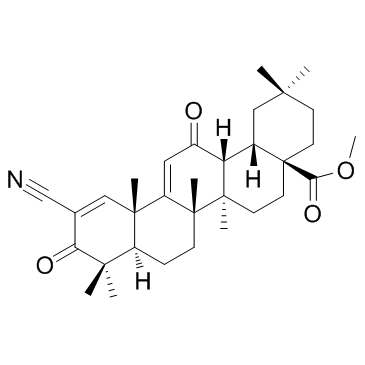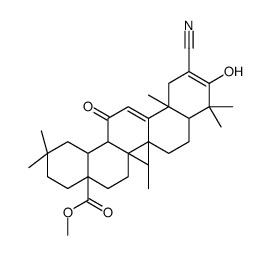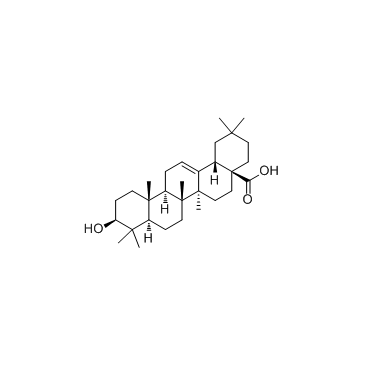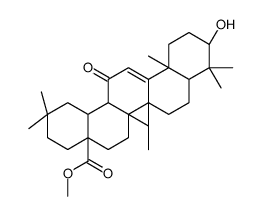218600-53-4
| Name | methyl (4aS,6aR,6bS,8aR,12aS,14bS)-11-cyano-2,2,6a,6b,9,9,12a-heptamethyl-10,14-dioxo-1,3,4,5,6,7,8,8a,14a,14b-decahydropicene-4a-carboxylate |
|---|---|
| Synonyms |
Methyl 2-cyano-3,12-dioxooleana-1,9(11)-dien-28-oate
2-cyano-3,12-dioxoolean-1,9(11)-dien-28-oic acid methyl ester 2-Cyano-3-(2-thienyl)thioacrylamide Bardoxolone (methyl) 2-cyano-3-(thiophen-2-yl)thioacrylamide 2-cyano-3,12-dioxooleane-1,9(11)-dien-28-oic acid methyl ester Oleana-1,9(11)-dien-28-oic acid, 2-cyano-3,12-dioxo-, methyl ester Bardoxolone methyl Propenethiamide,2-cyano-3-(2-thienyl) 2-cyano-3,12-dioxooleana-1,9(11)-dien-28-acid methyl ester 2-cyano-3-(2-thienyl)-2-propenethioamide 2-cyano-3,12-dioxoolean-1,9-dien-28-oic acid,methyl ester (2E)-2-Cyano-3-(2-thienyl)-2-propenethioamide Bardoxolone methyl ester (E)-2-cyano-3-thiophen-2-yl-thioacrylamide 2-cyano-3-thien-2-ylprop-2-enethioamide RTA-402 |
| Description | Bardoxolone is a synthetic triterpenoid compound with potential antineoplastic and anti-inflammatory activities, acting as an activator of the Nrf2 pathway and an inhibitor of the NF-κB pathway. |
|---|---|
| Related Catalog | |
| Target |
Nrf2[1] |
| In Vivo | Bardoxolone Methyl (30 mg/kg, p.o.) decreases renal expression of megalin but not cubilin, increases creatinine clearance and urinary albumin-to-creatinine ratios, and induces Nrf2 cytoprotective targets in cynomolgus monkeys[1]. Bardoxolone Methyl could induce overall favorable effects on the heart via its improvement in eGFR in both animal models and clinical trials[2]. |
| Kinase Assay | Kidney tissue from the 28-day monkey study is snap-frozen in liquid nitrogen, and stored at -80°C until analysis. Kidney tissue is homogenized at 250 mg tissue/mL ice cold PBS (pH 7.2), containing 2 mM ethylenediaminetetraacetic acid (EDTA). Homogenates are then centrifuged at 10,000 x g for 10 minutes at 4°C. The supernatants are collected and stored at -80°C until analysis. Protein concentrations of tissue homogenates are determined using the Bicinchoninic Acid (BCA) Protein Assay Kit from Pierce Biotechnology. NQO1 enzyme activity is determined by quantifying the rate of reduction of 2,6-dichlorophenol-indophenol (DCPIP). Gsr enzyme activity is determined using a commercially available kit. All enzyme activities are normalized to protein and presented as fold vehicle control. |
| Animal Admin | Two separate in-life studies are conducted in cynomolgus monkeys. In one study, cynomolgus monkeys (n=9/gender/dose group) are administered amorphous bardoxolone methyl by oral gavage, using sesame oil as the vehicle, at 5, 30, and 300 mg/kg once daily for 12 months in a GLP environment. Observations for morbidity, mortality, injury, and the availability of food and water are conducted twice daily for all animals. Clinical observations and body weights are conducted and recorded weekly. Weight data are analyzed by calculating the area under the weight versus time curve using the linear trapezoidal method. Blood samples for clinical chemistry evaluations are collected from all animals pretest and from all animals prior to interim (6-month) and terminal (12-month) necropsies. An additional group of monkeys for each dose group are allowed to recover for 4 weeks. |
| References |
| Density | 1.2±0.1 g/cm3 |
|---|---|
| Boiling Point | 600.8±55.0 °C at 760 mmHg |
| Melting Point | 215-223 °C |
| Molecular Formula | C32H43NO4 |
| Molecular Weight | 505.688 |
| Flash Point | 256.5±21.7 °C |
| Exact Mass | 505.319214 |
| PSA | 84.23000 |
| LogP | 6.22 |
| Vapour Pressure | 0.0±1.7 mmHg at 25°C |
| Index of Refraction | 1.559 |
| Storage condition | -20 °C |
| RIDADR | NONH for all modes of transport |
|---|---|
| HS Code | 2926909090 |
| Precursor 8 | |
|---|---|
| DownStream 1 | |
| HS Code | 2926909090 |
|---|---|
| Summary | HS:2926909090 other nitrile-function compounds VAT:17.0% Tax rebate rate:9.0% Supervision conditions:none MFN tariff:6.5% General tariff:30.0% |








![Methyl 12-oxoisoxazolo[4,5-b]olean-9(11)-en-28-oate structure](https://image.chemsrc.com/caspic/207/218600-52-3.png)

